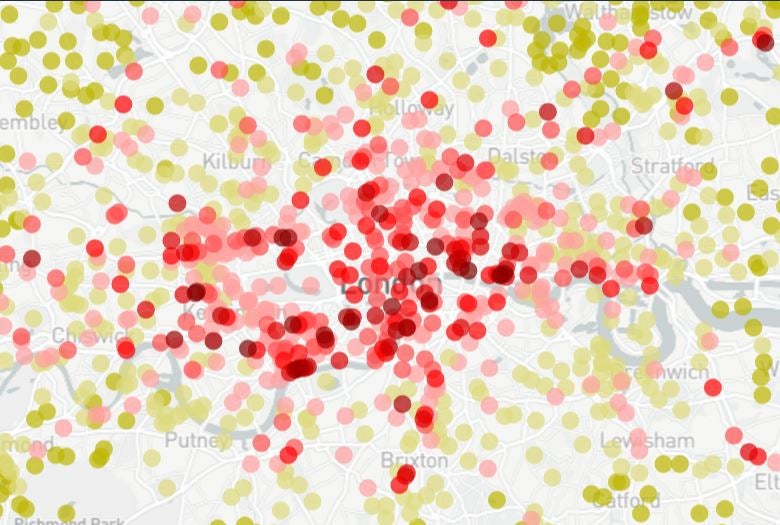Map reveals which London parks have illegal pollution levels
Hyde Park, Regent's Park and Green Park have some of worst air quality in the capital

Your support helps us to tell the story
From reproductive rights to climate change to Big Tech, The Independent is on the ground when the story is developing. Whether it's investigating the financials of Elon Musk's pro-Trump PAC or producing our latest documentary, 'The A Word', which shines a light on the American women fighting for reproductive rights, we know how important it is to parse out the facts from the messaging.
At such a critical moment in US history, we need reporters on the ground. Your donation allows us to keep sending journalists to speak to both sides of the story.
The Independent is trusted by Americans across the entire political spectrum. And unlike many other quality news outlets, we choose not to lock Americans out of our reporting and analysis with paywalls. We believe quality journalism should be available to everyone, paid for by those who can afford it.
Your support makes all the difference.Hundreds of London’s green spaces, including Hyde Park and Regent's Park, have potentially hazardous air pollution levels which exceed the European legal limit, according to new research.
Nearly a quarter of the capital’s open parks have over 40 micrograms of nitrogen dioxide per cubic metre of air, which represents the EU limit, with some having more than double that quantity.
Green Park, St James’s Park, Clapham Common and Kensington Gardens are among the other well-known green spaces which currently have illegal pollution levels.
The report was commissioned by data science company ASI and brought together air quality data from over 100 sensors spaced across the capital. The organisation has created a detailed pollution map, labelling parks with dangerous levels with a red circle.
According to ASI, the most polluted green space in London is Whittington Garden near St Paul’s Cathedral, which reportedly has a nitrogen dioxide rate of 99.5 micrograms per cubic metre.
Other parks making up the top five are the gardens at the rear of Langham Mansions; St Mary's Square; Redbridge Roundabout; and the Royal Crescent Mews Amenity Area. All five spaces are situated near major tube stations.
Meanwhile the least polluted open spaces tended to be on the outskirts of the city, with Hampton Court in the south west and Dagnam Park in the north east being among the cleanest.
ASI’s Pablo Mosteiro helped produce the research to inform London’s 8.7 million population of the dangers of air pollution in parks.
"Huge numbers of Londoners are unknowingly going for walks, playing with their children and having their lunchtime sandwich in open spaces with appalling air quality," he said.
“Our new website will allow them to see whether there are any better and cleaner alternatives nearby.”
ASI chief executive Marc Warner added: “The city's parks are often referred to as the ‘lungs of London'. We now know that these lungs aren't as healthy as we'd hoped.”
“The new Mayor is going to have to prioritise clean air policies so that we can make our parks and open spaces the healthy places they're meant to be.”
Mayor of London Sadiq Khan made the improvement of the capital’s air quality a central part of his manifesto and has been praised for swiftly introducing new proposals to that end.
In June it was announced plans for an extended ultra-low emission zone to be introduced as part of a major public consultation by City Hall, after it emerged almost 10,000 Londoners die from long-term exposure to air pollution every year.
Discussing the new proposals, Mr Khan said: “Just as in the 1950s, air pollution in London today is literally killing Londoners. But unlike the smoky pollution of the past, today’s pollution is a hidden killer.
“The scale of the failure to tackle the problem is demonstrated by the failure of the Government and the previous Mayor to meet legal pollution limits. Urgent action is now needed to ensure Londoners no longer have to fear the very air we breathe.”
Approximately 47 per cent of the capital city is thought to be green space.
It took the city just eight days in 2016 to surpass the annual cap on nitrogen dioxide concentrations, and the World Heath Organization estimates air pollution costs the UK £62bn annually.
Join our commenting forum
Join thought-provoking conversations, follow other Independent readers and see their replies
Comments